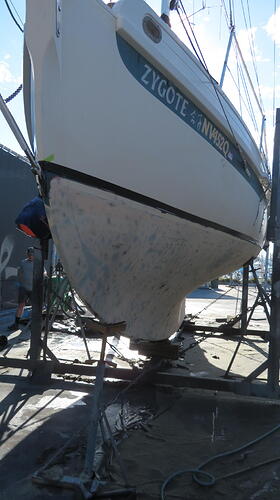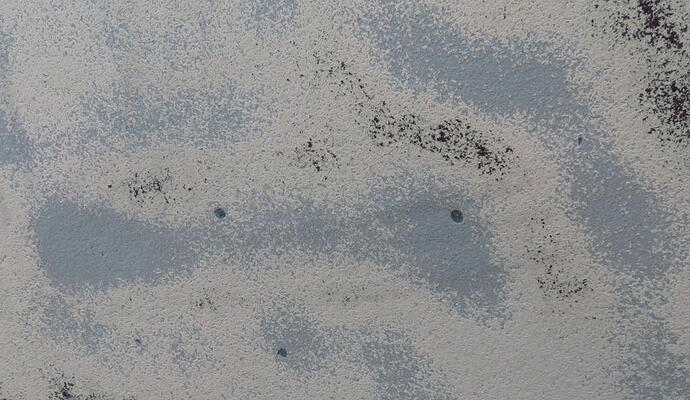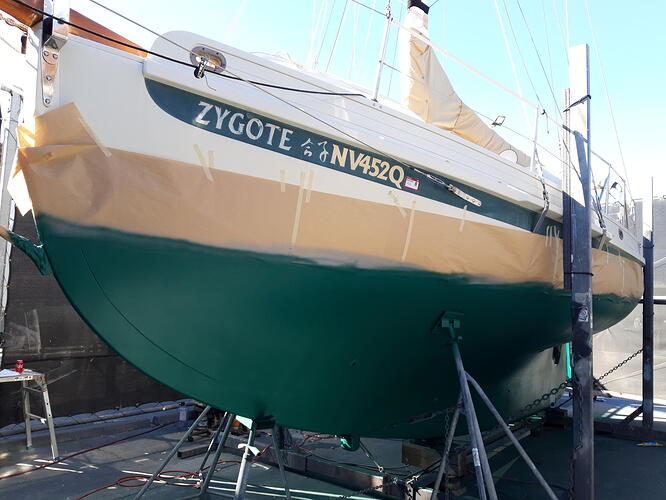Nine years ago, I reported the results of readings I took with a moisture meter of Zygote’s hull. That was when Z was 11 years old (see: Zygote: 11 years later: Hull moisture - BCC Forum - Sam L Morse Forum).
To recap, when we commissioned construction of Z by Sam L. Morse Co., we specified a vinylester (instead of polyester gelcoat) skin below the waterline and three coats of Interlux Interprotect epoxy barrier coat over the vinylester. Roger and Sumio at Sam L. Morse Co told me that the Interprotect barrier coat should remain effective for 20 years.
Government restrictions due to Covid-19 disturbed our sailing and maintenance schedule in the first half of 2020. We just last week took the opportunity to organise haul-out, after hiring contractors to peel the hull of old antifoul and the 20-year old barrier coat.
After haul-out and a pressure wash on Tuesday, the hull looked fine.
Wednesday the sand-blasting team arrived, armed with beads of recycled glass averaging 380 microns (likely about 0.015 inch, if my conversion is correct) in diameter as the abrasive medium.
See blasted.jpg, a photo taken when the blasting team left. Twenty years of ablative antifoul (or what had not ablated) had disappeared, leaving some of the white barrier coat still over the grey vinylester.
Closer inspection of the hull revealed 20-25 small pock marks on each of starboard and port sides. Some of those pox were just in the white epoxy. Others went into the vinylester. And a few more went into the GRP.
See polyps4.jpg for a close up. The smears of black, especially near top right, are remnant black Micron Extra antifoul. The white, as noted above, is remnant barrier coat, and the grey the vinylester. See the black in one of the pits? As far as I can remember, that’s part of the GRP layup. Most of the pox are about 2 mm in diameter, with a couple three about 5 mm dia. (2 mm is about 0.08" and 5 mm about 0.2").
I liken the discovery of those pox to the discovery of polyps during a colonoscopy. Better to discover and remove when they are tiny and still benign.
Light sanding to remove the remnant epoxy barrier coat opened some pits wider.
Thursday afternoon we started rolling on a new barrier coat. This time using a Jotun product, Jotamastic 90 AL. That’s a high solids polyamide epoxy with mobs of tiny aluminum flakes (invisible to my eye - it’s just another grey coating). It’s much used on steel-hulled ships as an anti-corrosion protection coating. The aluminium flakes supposedly reduce the penetration of water and add flexibility to the cured coating. It rolls on easily and cures in a couple of hours, allowing two coats a day.
We’re aiming for 5 - 6 coats of the Jotamastic barrier coat, because I don’t have a wet film thickness gauge.
I’ve budgeted for another week in the work pen on the hard. Next week we’ll arrange for the yard Travelift to visit and reblock Z, so we can tackle the keel covered at the moment by blocks and the hull covered by stand pads.



